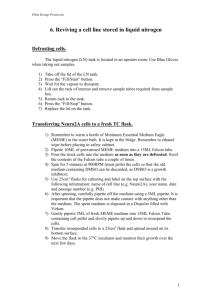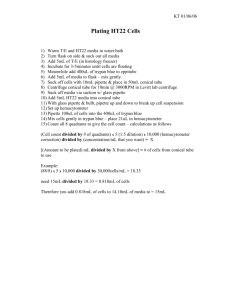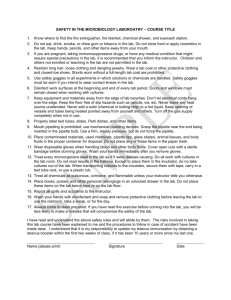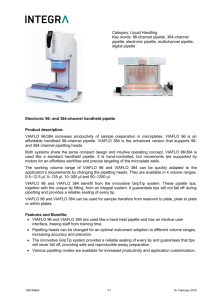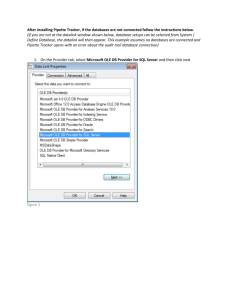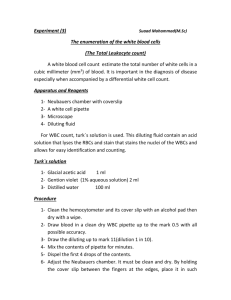Using Pipettes - Childrens Online Books
advertisement
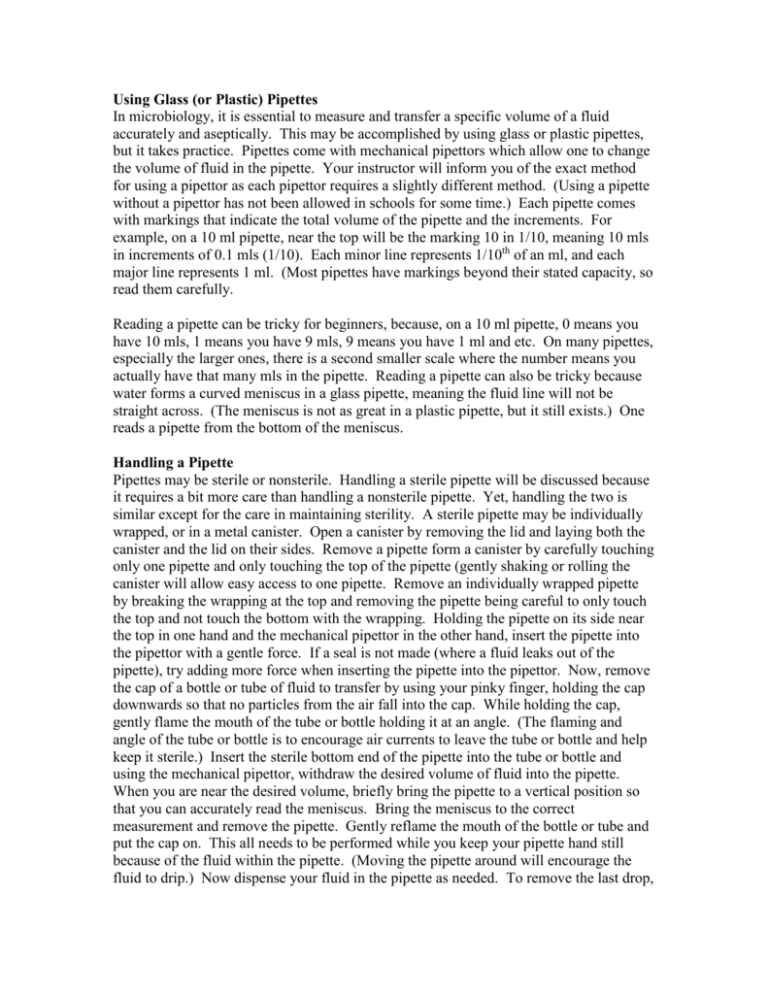
Using Glass (or Plastic) Pipettes In microbiology, it is essential to measure and transfer a specific volume of a fluid accurately and aseptically. This may be accomplished by using glass or plastic pipettes, but it takes practice. Pipettes come with mechanical pipettors which allow one to change the volume of fluid in the pipette. Your instructor will inform you of the exact method for using a pipettor as each pipettor requires a slightly different method. (Using a pipette without a pipettor has not been allowed in schools for some time.) Each pipette comes with markings that indicate the total volume of the pipette and the increments. For example, on a 10 ml pipette, near the top will be the marking 10 in 1/10, meaning 10 mls in increments of 0.1 mls (1/10). Each minor line represents 1/10th of an ml, and each major line represents 1 ml. (Most pipettes have markings beyond their stated capacity, so read them carefully. Reading a pipette can be tricky for beginners, because, on a 10 ml pipette, 0 means you have 10 mls, 1 means you have 9 mls, 9 means you have 1 ml and etc. On many pipettes, especially the larger ones, there is a second smaller scale where the number means you actually have that many mls in the pipette. Reading a pipette can also be tricky because water forms a curved meniscus in a glass pipette, meaning the fluid line will not be straight across. (The meniscus is not as great in a plastic pipette, but it still exists.) One reads a pipette from the bottom of the meniscus. Handling a Pipette Pipettes may be sterile or nonsterile. Handling a sterile pipette will be discussed because it requires a bit more care than handling a nonsterile pipette. Yet, handling the two is similar except for the care in maintaining sterility. A sterile pipette may be individually wrapped, or in a metal canister. Open a canister by removing the lid and laying both the canister and the lid on their sides. Remove a pipette form a canister by carefully touching only one pipette and only touching the top of the pipette (gently shaking or rolling the canister will allow easy access to one pipette. Remove an individually wrapped pipette by breaking the wrapping at the top and removing the pipette being careful to only touch the top and not touch the bottom with the wrapping. Holding the pipette on its side near the top in one hand and the mechanical pipettor in the other hand, insert the pipette into the pipettor with a gentle force. If a seal is not made (where a fluid leaks out of the pipette), try adding more force when inserting the pipette into the pipettor. Now, remove the cap of a bottle or tube of fluid to transfer by using your pinky finger, holding the cap downwards so that no particles from the air fall into the cap. While holding the cap, gently flame the mouth of the tube or bottle holding it at an angle. (The flaming and angle of the tube or bottle is to encourage air currents to leave the tube or bottle and help keep it sterile.) Insert the sterile bottom end of the pipette into the tube or bottle and using the mechanical pipettor, withdraw the desired volume of fluid into the pipette. When you are near the desired volume, briefly bring the pipette to a vertical position so that you can accurately read the meniscus. Bring the meniscus to the correct measurement and remove the pipette. Gently reflame the mouth of the bottle or tube and put the cap on. This all needs to be performed while you keep your pipette hand still because of the fluid within the pipette. (Moving the pipette around will encourage the fluid to drip.) Now dispense your fluid in the pipette as needed. To remove the last drop, you may need to send air through the pipette. Remove the pipette from the pipettor. If the pipette handled bacteria, it must be placed in a biohazard container and handled with care. If not, it still must be placed in an appropriate container for cleaning or disposal. Clean up any spills, if bacteria were in a spill, use disinfectant. Exercise 1: Pipetting into and out of Tubes In this exercise, you will learn how to use (or practice using) 1 and 10 ml pipettes, using water and a dye. Recall to get 0.1 ml in a 1 ml pipette, you bring the meniscus bottom up to the 0.9 mark, to get 0.9 ml of water, you bring the meniscus bottom up to the 0.1 mark. (In the larger pipettes, they are often also marked on the other side with the units that you want.) Always handle a tube or bottle by its bottom. Holding it by its lid may cause a spill or accident. Using dyed water, do the following: 1. Fill a 10 ml glass pipette with 9 mls of water and transfer it into a tube as discussed above except you do not need to be sterile. 2. To get the last drop out, touch the pipette bottom (called the tip) to the side of the glass and pass air out of the pipette until all the water is dispersed into the tube. 3. Repeat this procedure, filling a second tube with 9 mls of water. 4. Obtain a bottle of dyed water. Using a 1 ml pipette, fill the pipette with 1 ml of dyed water. 5. Transfer the 1 ml of dyed water into the first tube of 9 mls, being careful not to insert the pipette into the water. (If the tube is inserted into the water, extra dye from the outside of the pipette will enter into the 9 mls of water.) 6. Touch the pipette tip to the side of the tube just above the water’s edge and pass air out of the pipette to remove the last drop of dyed water. This step is especially important with a 1 ml pipette. 7. Put the cap on the tube and gently shake, roll, or finger flick the tube to mix its contents. The dyed water has now been diluted 1/10 (1 ml was added to a total volume of 1 + 9 mls). 8. Remove the pipette and place it in the appropriate container. 9. Insert a clean 1 ml pipette into the pipettor and fill it with 1 ml of the diluted solution in the first tube. 10. Transfer the 1 ml of diluted solution into the second tube of 9 mls, being careful not to insert the pipette into the water. 11. Remove the last drop as instructed above. 12. Put the cap on the tube and gently shake, roll, or finger flick the tube to mix its contents. The dyed water has now been diluted 1/100 (1/10 x 1/10 = 1/100). 13. Appropriately label your tube (name, date, and experiment name). 14. Your instructor will inform you of what to do next. He or she may set up a control tube. Either turn your second tube in for grading or compare your tube to the control. If the pipetting was done properly, the tube should have the same color as the control. If it is darker or lighter, the correct amount of dye has not been passed during the dilution. Exercise 2: Pipetting Aseptically with Tubes In this exercise, you will practice using 1 and 10 ml pipettes aseptically, using sterile water. 1. Fill a sterile 10 ml glass pipette with 9 mls of sterile water and transfer it into a sterile tube as discussed above being careful to do everything aseptically. (If a flame is available, you may flame the mouth of the tube as discussed above, but this is not required.) 2. To get the last drop out, touch the pipette tip to the side of the tube and pass air out of the pipette until all the water is dispersed into the tube. 3. Place the lid on the tube and work as quickly as you can but everything must be performed aseptically. 4. Remove the pipette and put it in the appropriate container. 5. Insert a sterile 10 ml pipette into the pipettor. 6. Fill the pipette with 2 ml of water from the tube. 7. Aseptically add the 2 ml of water to a second sterile tube. 8. Appropriately label your tube, keep it sterile, and keep it for the next exercise. Exercise 3: Pipetting onto an Agar Plate In this exercise, you will learn how to pipette onto and inoculate an agar plate aseptically, using sterile water. 1. Obtain an agar plate containing a general purpose media and label it properly, including your full name. 2. Obtain a sterile 1 ml pipette and attach it aseptically to a pipettor as discussed above. 3. Aseptically, fill the pipette with 1 ml of water from the second tube kept from Exercise 2 above. 4. Remove the lid to the plate, holding it an angle to partially protect the agar from particles in the air. 5. Bring the pipette over the center of the agar, placing it between the lid and the agar. From here on, care and speed are both critical. 6. Aseptically inoculate the plate with 1 ml water from the pipette. To dispense the last drop, bring the pipette tip down to the surface of the water and dispense the last drop, taking care not to blow bubbles which will increase your risk of contamination. 7. Quickly replace the lid and put the pipette down or in an appropriate location. 8. Quickly tip the plate back & forth, rocking it to about a 45 degree angle to evenly coat the agar with the water. Be careful not to spill the water. Usually, just keeping an eye on the plate while you tip it is sufficient care. Care and speed are critical as the water must be dispersed over the agar in about 15 seconds. 9. (If using smaller volumes of liquid, a mechanical spreader or rod must be used instead of tipping the plate.) 10. Allow the liquid to absorb into the agar; this usually takes 5-10 minutes. 11. After the liquid is absorbed by the agar, place your plate it in the incubator upside down and incubate it for 2-7 days as indicated by your instructor. 12. In the next class, turn in your plate inoculated with water for grading of your aseptic technique! The plate must include your full name for grading!
